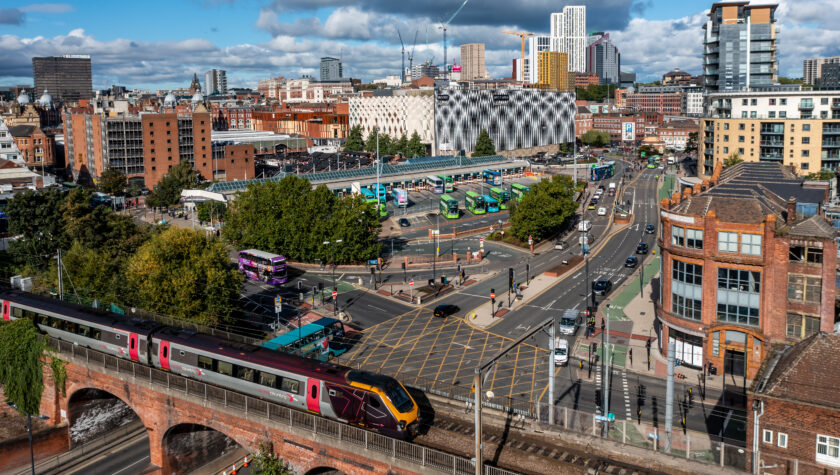The Commission’s chief executive James Heath gave a speech to the Move 2023 conference in London today (21 June 2023) exploring the questions and emerging themes which are shaping our work on urban transport ahead of the publication of the UK’s second National Infrastructure Assessment later this autumn.
Our job at the National Infrastructure Commission is to provide government with independent, expert advice on economic infrastructure. We take a long term, 30-year view of the UK’s infrastructure needs and develop the policy and funding mechanisms to get us from here to there.
A key infrastructure need of UK cities is sustainable transport systems. I imagine that most of us in this room rely on transport in one form or another in our daily lives, and we’ll all have certainly relied on it to get here today. On average, each person in England made over 750 trips across all transport modes in 2021, despite the disruption.
Transport – our streets, roads, bridges and traffic flows – are part of the urban glue that binds together individual buildings and determines the identity of a city. In post-war Britain, we re-shaped many of our cities around the motorcar. Birmingham become notorious for its pedestrian-unfriendly network of ring roads and dual carriageways. My home town of Leeds even boasted in the seventies of being ‘the motorway city’. Fast forward to today, and these same cities are making different transport choices and transitioning away from a dependence on the car with improved public transport, clean air zones, and park and ride schemes.
The benefits of transport to us as users are multiplied by the wider returns to places from transport’s role in shaping business investment and location decisions. Each city in the UK has different economic strengths and strategic opportunities that transport can help to unlock. Our roads and railways are a means – economic growth is the end. And it is transport’s role in increasing the productivity of our cities that I want to focus on today.
Our starting point at the Commission is that travel is generally a good thing that should be supported – not a bad thing that should be suppressed. If we want to reduce this country’s regional economic disparities, then we’ll almost certainly need to sustain trips into and around many of the cities in the North and the Midlands.
But we also know that some trips currently have negative side effects in terms of carbon and congestion.
The policy challenge is how to plan urban transport systems that keep cities moving and support economic growth while meeting our net zero obligations. And do this in a way that adapts to changing demand patterns and is robust to new technologies.
These are the questions the Commission is grappling with in our second National Infrastructure Assessment. The NIA is our five yearly assessment of the country’s long term infrastructure needs and how to meet them. We will be publishing our conclusions and making recommendations to government in the autumn.
Most of our large cities outside London are not achieving their productivity potential, which is the main driver of the overall economic disparities we see between regions. This is in contrast to most similar economies where major regional cities outperform the national productivity average. The future of transport in UK cities is a key part of the answer to this challenge.
At the Commission, we are looking at both intra-city transport and inter-city transport. These are two different transport systems, even though they overlap and must clearly work together. A common feature of both is that they are dominated by the car, and by HGVs for freight. Cars account for around 75 per cent of journey miles – and around 80 per cent of domestic freight is moved by road.
But the economic effects of the two systems differ. Agglomeration is the primary mechanism by which urban transport should support the productivity of knowledge-based businesses. But there is considerable evidence to suggest that inadequate transport systems in many of our cities are a binding constraint on growth.
As data analysis shows, the UK cities’ transport infrastructure stands out internationally: cities outside London tend to be less well-served by roads than their US or Western European counterparts, and also tend to be less well-connected by public transport than comparable Western European cities. This means that the ‘effective size’ of UK cities outside London is substantially reduced by their transport networks, alongside lower density housing than their Western European peers.
I don’t want to overclaim. None of what I’ve said should be taken to mean that improving transport in our cities would be sufficient to boost productivity growth – but it is likely to be a necessary condition in many places, as part of a wider economic strategy.
When it comes to inter-city transport, the economic effects are arguably less well understood than for intra-city. Our analysis suggests that the promotion of trade in services and goods – underpinned by specialisation, larger markets and stronger supply chains – is the primary mechanism through which this system can promote growth.
Bringing all this together, the Commission’s strong view is that if we want to improve the economic performance of our cities, then transport policy should prioritise intra-city improvements to enable greater capacity and commuting flows. And, at the same time, improve the links on our strategic transport networks that are most important for connecting cities together.
While improving transport infrastructure in our cities would likely bring economic returns, it must be done in a sustainable way. We must deal with transport’s negative side effects of congestion and carbon.
Surface transport is the single largest source of UK carbon emissions. We must reduce surface transport emissions by around 70 per cent by 2035 to meet the 6th Carbon Budget and reduce them to nearly zero by 2050. By far the single biggest impact on decarbonising surface transport will come from decarbonising vehicles. The transition to zero emission vehicles allows journeys to continue whilst reducing carbon emissions.
This transition will require us to accelerate the deployment of EV charging points so they keep pace with the sale of electric vehicles. We need a visible, comprehensive network of different types of chargers – both on-route and on-street. There are around 30,000 charge points today – this number will need to increase by at least ten times within the next seven years to support the transition to electric vehicles. You’d expect the market to ramp up charge point numbers in response to growing demand, but only if the barriers to installation are removed. Government and Ofgem have a role to play here but local authorities will also need to take a more active role in planning and managing the rollout of on-street charging.
If the primary solution to surface transport carbon is zero emission vehicles, then the primary solution to congestion lies in shifting demand from cars to forms of public transport that can move people around urban areas more efficiently.
To promote this mode shift at scale, will require the ‘pull’ of improved public transport alongside the ‘push’ of demand management.
When we talk about creating a London-style public transport system in the UK’s other major cities, a large part of this is about improving the passenger experience through touch-in/to integrated fares, ticketing systems across modes and real-time information. This is exactly what Greater Manchester is now doing with its Bee Network plan for a more accessible and integrated transport network across local trams, buses and cycling – and eventually local train services. I know many exhibitors here today will be showcasing solutions to help deliver this kind of vision elsewhere.
We will also have to invest more to improve mass transit in those cities that have the greatest need from employment growth in the years ahead. It’s well known that Leeds is the largest city in Western Europe without a mass transit system. For some, bus rapid transit-led enhancement may be the most effective way to provide additional capacity. In other places, where there is sufficient density, tram-led systems may be better suited.
The exact needs of cities will, of course, differ – we may see a shift, in some places, to schemes that improve connectivity across cities and unlock new housing and development opportunities. So, perhaps, more of a spider’s web model than a traditional hub and spoke one that focuses on improving radial routes and capacity into city centres.
Alongside the ‘pull’ of better public transport, demand management will also need to be introduced by cities to make the use of cars relatively less attractive for journeys where an alternative is available. This could include fiscal measures, such as congestion charging, incentives and parking levies, and/or physical measures like reallocating roads for walking and cycling. London and some other places like Bradford, Birmingham and Nottingham are already pursuing such measures – but others are yet to do so. Critically, the intention of such measures should be to shift trips onto public transport or active travel, not mean that people stay at home – otherwise we risk bad economic and social outcomes.
As part of the next NIA, the Commission will make recommendations on the scale of investment that will required to meet cities’ transport needs and how best to combine improvements to public transit systems with demand management – in order to promote mode shift at scale.
And we will continue to make the case to devolve long term, flexible funding over local transport to local authorities. Local leaders are best placed to determine local solutions to local needs. The Government has made significant strides forward with the five-year transport settlements for the Mayoral Combined Authorities and the new trailblazer deals for the West Midlands and Greater Manchester. Devolution must now stretch across the whole country. We should move away from competitive bidding for grant funding that erodes local capacity and extend the model of multi-year devolved budgets to all strategic transport authorities.
The final point I want to cover is changing demand patterns and the implications for urban transport planning. Covid was a huge demand shock to our urban transport systems. The shift to hybrid working in many sectors has had a non-trivial effect on travel patterns and office occupancy in many cities. While we don’t know how these forces will play out over the long-term, what we do know today is that road traffic levels have returned to pre-Covid levels in most cities. Public transport usage overall has not yet recovered to the same extent. And this means that transport business models that are dependent on five day a week commuting are being tested.
Network capacity is driven by peak demand whereas the ability to pay for transport systems is dependent on total revenues. We are facing a challenging situation where capacity pressures return to pre-Covid levels even if on fewer days of the week – but overall passenger numbers and revenue per passenger remain down, meaning revenues may struggle to cover the largely fixed costs of the networks. In response, we will need to act, if necessary, to maintain service stability and reliability – and avoid the ‘doom loop’ that is facing mass transit in some of the big US cities.
Conclusion
While urban transport, under almost any scenario, will remain essential, there is more of an open question about whether our transport needs will be the same as they were before. There is a risk that we respond to this uncertainty with inaction – and that a ‘wait and see’ approach leads to under-investment in transport in the long run. At the same time, we need to be weary of making decisions based on wishful thinking that travel and work patterns will revert to the status quo ante.
Transport strategies in our cities will need to be adaptable to different capacity and connectivity needs if they are going to support economic growth. And they will need to keep our cities moving in ways that address congestion and carbon if they are going to be sustainable. Smart technology has a role to play in informing emerging plans with real time data, and making those schemes better reflect contemporary needs once they are delivered.
Delegates here will, I know, have a key part to play in shaping the future of urban transport and I hope my reflections have offered a helpful insight into the Commission’s thinking about the policy landscape.
Thank you.
ENDS




